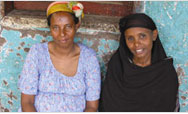Conflict Management
Conflict is one of the most significant obstacles to development in Africa today. Approximately half of sub-Saharan African countries have experienced violent armed conflict in the past five years. According to a recent University of Maryland assessment of 160 countries world wide on their capacity for peace building and ability to avoid destabilizing political crises, no region has more potential for future conflict than Africa. Nineteen of the 25 countries with the highest risk on instability are in sub-Saharan Africa. Most countries across the broad middle belt of Africa-from Somalia in the east to Sierra Leone in the west, and from Sudan in the north to Angola in the south-has a potentially volatile mix of poor human security, unstable or inequitable political institutions, limited or poorly managed resources, and, inevitably, a "bad neighborhood" of states similarly vulnerable to crisis.
These conflicts have undermined progress in health, economic growth, and governance; created conditions that have resulted in breeding grounds for terrorism; and required costly humanitarian assistance. The pervasive consequences of long-term poverty and warfare complicate the prospects for stability. These consequences include: deteriorating sanitation and health and, especially, the related AIDS pandemic; widespread and recurring food insecurity; and large numbers of refugee, displaced, and otherwise marginalized populations. Food insecurity, floods, droughts, and epidemics often combine with conflict to create complex emergencies with devastating effects.
Through its programs in 22 presence countries and three regional offices, USAID strives to improve the lives of Africans in conflict-affected regions or countries. USAID targets these conflict affected areas by systematically developing integrated conflict response strategies that address the underlying problems fueling violent conflict as well as mitigating more immediate threats to peace and stability which often drive cycles of conflict.
"Conflict" is defined as a struggle over values or claims to status, power (i.e., through the politicization of identity) and scarce resources (for example land, water, natural resources, minerals, and food), among two or more parties that perceive incompatible interests or express hostile attitudes. Prevention activities target specific issues involving actions, policies, procedures, institutions, or conditions in order to minimize socio-cultural, economic, or political divisions. The aim is to help groups work together and forestall broad-based instability and violent conflict. Mitigation efforts contain and reduce violence as a way of lessening the damage done to the population and the development investments in affected countries.
The guiding rule for conflict management activities is "do no harm." Resolution efforts seek an end to ongoing conflict through mediation, alternative dispute resolution, or other formal and informal methods of arbitration. The reconciliation process involves reestablishing government units and civil society (e.g., community, labor, and business groups) and enabling them to solve disputes through political institutions and other means. Short-term efforts may involve truth and reconciliation commissions, special tribunals, indigenous peace building or dispute resolution, and other channels. Long-term efforts may include reconciliation among formerly warring parties or vulnerable populations, specifically women and youth, and establishing human rights guarantees.
USAID networks with African partners, who ultimately own the outcome of their peace process, and assists them, through offices in Africa, to promote state-of-the-art approaches, tools, and experience in assessing an area's vulnerability to conflict. USAID promotes stronger coordination, networking, and action in conflict prevention and management.
USAID activities fit into two categories: (a) conflict response and mitigation programs that aim to avert imminent violence, mitigate ongoing violence, or address its immediate aftermath (e.g., mediation, community-based reconciliation, peace media, reintegration); and, (b) conflict management programs that address the underlying causes and consequences of conflict (e.g., youth unemployment, ethnically based economic competition, natural resources such as land, water, and forests).
Back to Top ^ |


